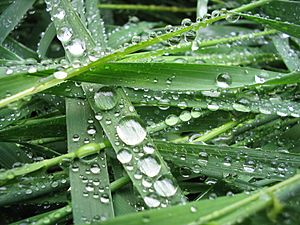Hydrophobe facts for kids
Hydrophobicity is a cool science word that describes how some things don't mix with water. Imagine oil and water – they just don't get along! When something is hydrophobic, it means it seems to be "scared" of water. These things are called hydrophobes. On the other hand, things that love water are called hydrophiles.
Contents
What is Hydrophobicity?
In chemistry, hydrophobicity is a special physical property. It means a molecule seems to be pushed away from a lot of water. This happens because of the way the molecules interact. It's like they have a natural dislike for each other!
Why Do Some Things Avoid Water?
When hydrophobic molecules are in water, they often stick together. They form tiny clumps, like little balls, called micelles. This happens because they are trying to get away from the water. It's like they are huddling together for comfort!
Everyday Examples of Hydrophobes
You see hydrophobic things all the time! Think about oils, fats, and anything greasy. These are all great examples of hydrophobic molecules. For instance, if you've ever tried to wash a greasy pan with just water, you know it's tough because the grease repels the water. Another example is the waxy coating on some leaves, which makes water drops roll right off.
How We Use Hydrophobic Materials
Because hydrophobic materials push water away, they are super useful!
- They can help remove oil from water.
- They are used to clean up oil spills in oceans and lakes.
- They also help in special chemical processes to separate substances that don't mix with water from those that do.
Images for kids
-
Dew drop on a hydrophobic leaf surface
See also
 In Spanish: Hidrófobo para niños
In Spanish: Hidrófobo para niños





